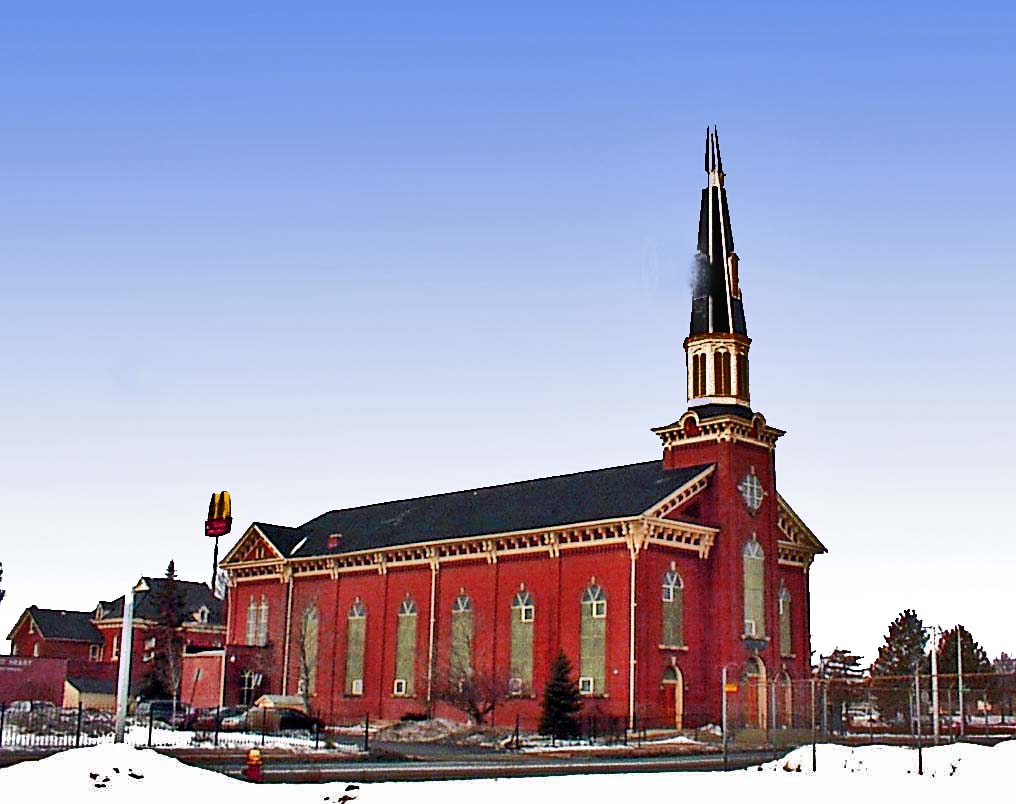

This impressive and beautiful church was constructed in 1875. It was, I believe, the third German Roman Catholic parish in Detroit following St. Mary’s on Monroe and St. Joseph’s now on Orleans. It is interesting to note that those two other parishes are within short walking distance of Sacred Heart, reminding us of the very high population density that once characterized this neighborhood. All three of these Roman Catholic churches are still serving the needs of the faithful; indeed, in those two parishes Mass is still offered in Latin every Sunday.
The impressive, if modest in size, Sacred Heart Church, was designed by Peter Dedrichs. There are conflicting claims about his natal location. Some biographies suggest that he was born in Detroit in 1856, but that implies that he designed Sacred Heart before his twentieth birthday. Others apparently think that he was born in Germany. Apparently, there is no doubt that he learned his architectural skills in Germany. He designed at least four impressive Detroit Catholic Churches that continued to serve believers into the 21st century: St. Mary’s on Monroe; the large St. Bonaventure Monastery on Mount Elliot; St. Charles Borremeo in Indian Village and the Sacred Heart Church that you see in this picture. Peter Dedrichs was also responsible for the construction of the Customs House in Detroit and for the Wayne County Court Building.
For Sacred Heath, Dedrichs designed a red-brick,
pedimented Italianate structure with an attractive projecting entrance along
Rivard. The
wood belfry and spire are impressive since they are painted in a rich, warm
cream, complementing the deep red of the brick that Dedrichs selected for
this
church. You will see roundhead fenestration with stone stills under the windows
and stone keystones above. This is an appealing combination, but also suggests
durability. Along both sides of this church are six bays with their attractive
two-story windows. The sacristy and service rooms are located in the seventh
bays, the one furthest away from Rivard and closets to the new McDonald’s
whose golden arches compete with the warm cream wooden spire of Sacred Heart
for attention when you view this church from Rivard. The church itself is,
I believe, the most lucid example of Italianate church architecture to be
found
in the Detroit area.
This parish was founded to serve the needs of German immigrants in the decade
after the Civil War. It did so, with not only the impressive Church that
Dedrich’s
designed, but with an elementary school and then a high school. At the time
of World War I, southern blacks arrived in large numbers and were confined
to the neighborhoods along Hastings, northwest from the Detroit River. As
the blacks
moved into Detroit, Germans moved to the further corners of the suburbs and
lost their need for German language Masses. In 1938, the Catholic diocese
of
Detroit converted Sacred Heart from a German parish to an African American
parish. The first Jim Crow parish, St. Peter Claver, had been founded for
black Catholics
in 1911, using the school, but not the church of St. Mary’s parish on
Monroe. St. Peter Claver was transformed into the racially changed Sacred
Heart
parish.
After World War II, much of the housing along Hastings was torn down to build the I-75 Expressway, a development strategy that was frequently called urban renewal in white Detroit and Negro removal in black Detroit. As you can see, Sacred Heart lost much of its catchment area with the building of the expressway. In 1957, the parish closed its secondary school and, eight years later, its primary school.
Architect: Peter Dederichs
Architectural Style: Late Gothic Revival/ Romanesque Italianate
Date of Construction: 1875
City of Detroit Local Historic District:
State of Michigan Registry of Historic Sites: P25215; Listed June 19, 1975
State of Michigan Historical Market: Erected October 25, 1978 and clearly visible
on the Rivard frontage of this beautiful and inspiring church
National Registry of Historic Places: # 80001926; Listed June 6, 1980
Use in 2004: Roman Catholic Church serving the needs of the city’s Roman
Catholics
Photo: Ren Farley; February 2004